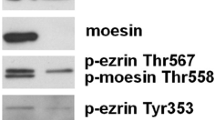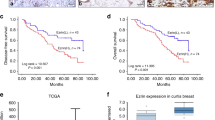Abstract
Expression of the metastasis-associated protein, ezrin, in over 5,000 human cancers and normal tissues was analyzed using tissue microarray immunohistochemistry. Ezrin staining was compared between cancers and their corresponding normal tissues, between cancers of epithelial and mesenchymal origin, in the context of the putative inhibitor protein, merlin, and against clinicopathological data available for breast, lung, prostate cancers and sarcomas. Ezrin was found in most cancers and normal tissues at varying levels of intensity. In general ezrin was expressed at higher levels in sarcomas than in carcinomas. By normalizing the expression of ezrin in each cancer using ezrin expression found in the corresponding normal tissue, significant associations between ezrin were found in advancing histological grade in sarcomas (P = 0.02) and poor outcome in breast cancer (P = 0.025). Clinicopathologic associations were not changed by simultaneous assessment of ezrin and merlin in each patient sample for the cancer types examined. These data support a role for ezrin in the biology of human cancers and the need for additional studies in breast cancer and sarcoma patients that may validate ezrin as a marker of cancer progression and as a potential target for cancer therapy.




Similar content being viewed by others
References
Gary R, Bretscher A (1995) Ezrin self-association involves binding of an N-terminal domain to a normally masked C-terminal domain that includes the F-actin binding site. Mol Biol Cell 6:1061–1075
Bretscher A, Edwards K, Fehon RG (2002) ERM proteins and merlin: integrators at the cell cortex. Nat Rev Mol Cell Biol 3:586–599
Yu Y et al (2004) Expression profiling identifies the cytoskeletal organizer ezrin and the developmental homeoprotein Six-1 as key metastatic regulators. Nat Med 10:175–181
Khanna C et al (2004) The membrane-cytoskeleton linker ezrin is necessary for osteosarcoma metastasis. Nat Med 10:182–186
Gautreau A, Poullet P, Louvard D Arpin M (1999) Ezrin a plasma membrane-microfilament linker, signals cell survival through the phosphatidylinositol 3-kinase/Akt pathway. Proc Natl Acad Sci USA 96:7300–7305
Hunter KW (2004) Ezrin, a key component in tumor metastasis. Trends Mol Med 10:201–204
Curto M, McClatchey AI (2004) Ezrin...a metastatic detERMinant? Cancer Cell 5:113–114
Algrain M, Turunen O, Vaheri A, Louvard D, Arpin M (1993) Ezrin contains cytoskeleton and membrane binding domains accounting for its proposed role as a membrane-cytoskeletal linker. J Cell Biol 120:129–139
Wan X, Mendoza A, Khanna C, Helman LJ (2005) Rapamycin inhibits ezrin-mediated metastatic behavior in a murine model of osteosarcoma. Cancer Res 65:2406–2411
Saotome I, Curto M, McClatchey AI (2004) Ezrin is essential for epithelial organization and villus morphogenesis in the developing intestine. Dev Cell 6:855–864
Ohtani K et al (2002) Ezrin, a membrane-cytoskeletal linking protein, is highly expressed in atypical endometrial hyperplasia and uterine endometrioid adenocarcinoma. Cancer Lett 179:79–86
Makitie T, Carpen O, Vaheri A, Kivela T (2001) Ezrin as a prognostic indicator and its relationship to tumor characteristics in uveal malignant melanoma. Invest Ophthalmol Vis Sci 42:2442–2449
Martin TA, Harrison G, Mansel RE, Jiang WG (2003) The role of the CD44/ezrin complex in cancer metastasis. Crit Rev Oncol Hematol 46:165–186
Tynninen O, Carpen O, Jaaskelainen J, Paavonen T, Paetau A (2004) Ezrin expression in tissue microarray of primary and recurrent gliomas. Neuropathol Appl Neurobiol 30:472–477
McClatchey AI (2003) Merlin and ERM proteins: unappreciated roles in cancer development? Nat Rev Cancer 3:877–883
Lallemand D, Curto M, Saotome I, Giovannini M, McClatchey AI (2003) NF2 deficiency promotes tumorigenesis and metastasis by destabilizing adherens junctions. Genes Dev 17:1090–1100
Nguyen R, Reczek D, Bretscher A (2001) Hierarchy of merlin and ezrin N- and C-terminal domain interactions in homo- and heterotypic associations and their relationship to binding of scaffolding proteins EBP50 and E3KARP. J Biol Chem 276:7621–7629
McClatchey AI, Giovannini M (2005) Membrane organization and tumorigenesis—the NF2 tumor suppressor, Merlin. Genes Dev 19:2265–2277
McClatchey AI et al (1998) Mice heterozygous for a mutation at the Nf2 tumor suppressor locus develop a range of highly metastatic tumors. Genes Dev 12:1121–1133
Nishizuka S et al (2003) Diagnostic markers that distinguish colon and ovarian adenocarcinomas: identification by genomic, proteomic, and tissue array profiling. Cancer Res 63:5243–5250
Borczuk AC et al (2003) Non-small-cell lung cancer molecular signatures recapitulate lung developmental pathways. Am J Pathol 163:1949–1960
Shah L et al (2004) Expression of syndecan-1 and expression of epidermal growth factor receptor are associated with survival in patients with nonsmall cell lung carcinoma. Cancer 101:1632–1638
Svensson S et al (2005) ERK phosphorylation is linked to VEGFR2 expression and Ets-2 phosphorylation in breast cancer and is associated with tamoxifen treatment resistance and small tumours with good prognosis. Oncogene 24:4370–4379
Rubin MA et al (2001) E-cadherin expression in prostate cancer: a broad survey using high-density tissue microarray technology. Hum Pathol 32:690–697
Hewitt SM (2004) Design, construction, and use of tissue microarrays. Methods Mol Biol 264:61–72
Berryman M, Franck Z, Bretscher A (1993) Ezrin is concentrated in the apical microvilli of a wide variety of epithelial cells whereas moesin is found primarily in endothelial cells. J Cell Sci 105(Pt 4):1025–1043
Brown MJ et al (2003) Chemokine stimulation of human peripheral blood T lymphocytes induces rapid dephosphorylation of ERM proteins, which facilitates loss of microvilli and polarization. Blood 102:3890–3899
Nakamura H, Ozawa H, (1996) Immunolocalization of CD44 and the ERM family in bone cells of mouse tibiae. J Bone Miner Res 11:1715–1722
Lach B, Gregor A, Rippstein P, Omulecka A (1999) Angiogenic histogenesis of stromal cells in hemangioblastoma: ultrastructural and immunohistochemical study. Ultrastruct Pathol 23:299–310
Bohling T et al (1996) Ezrin expression in stromal cells of capillary hemangioblastoma. An immunohistochemical survey of brain tumors. Am J Pathol 148:367–373
Weng WH, Ahlen J, Astrom K., Lui WO, Larsson C (2005) Prognostic impact of immunohistochemical expression of ezrin in highly malignant soft tissue sarcomas. Clin Cancer Res 11:6198–6204
Park PC et al (2003) Transcriptional profiling of medulloblastoma in children. J Neurosurg 99:534–541
Stokowski RP, Cox DR (2000) Functional analysis of the neurofibromatosis type 2 protein by means of disease-causing point mutations. Am J Hum Genet 66:873–891
Acknowledgements
This research was supported in part by the Intramural Research Program of the NIH, National Cancer Institute, Center for Cancer Research. Benjamin Bruce and Gaurav Khanna completed this work while participating in the Howard Hughes Medical Institute Fellowship. Contributions by the University of Michigan were supported by included National Cancer Institute Grants P01 CA093900 and Specialized Program of Research Excellence 1P50 CA69568.
Author information
Authors and Affiliations
Corresponding author
Electronic supplementary material
Rights and permissions
About this article
Cite this article
Bruce, B., Khanna, G., Ren, L. et al. Expression of the cytoskeleton linker protein ezrin in human cancers. Clin Exp Metastasis 24, 69–78 (2007). https://doi.org/10.1007/s10585-006-9050-x
Received:
Accepted:
Published:
Issue Date:
DOI: https://doi.org/10.1007/s10585-006-9050-x




